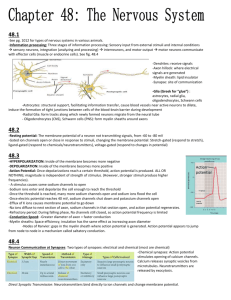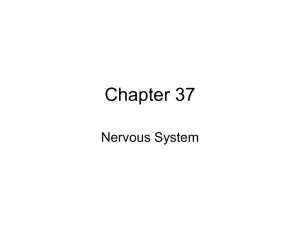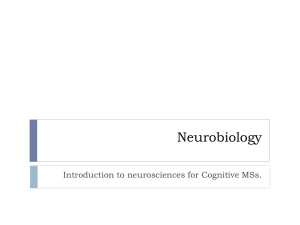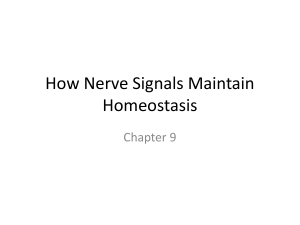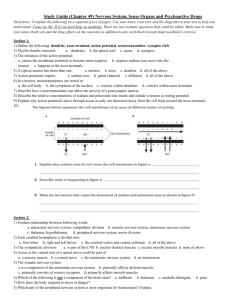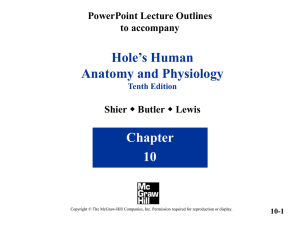File
advertisement
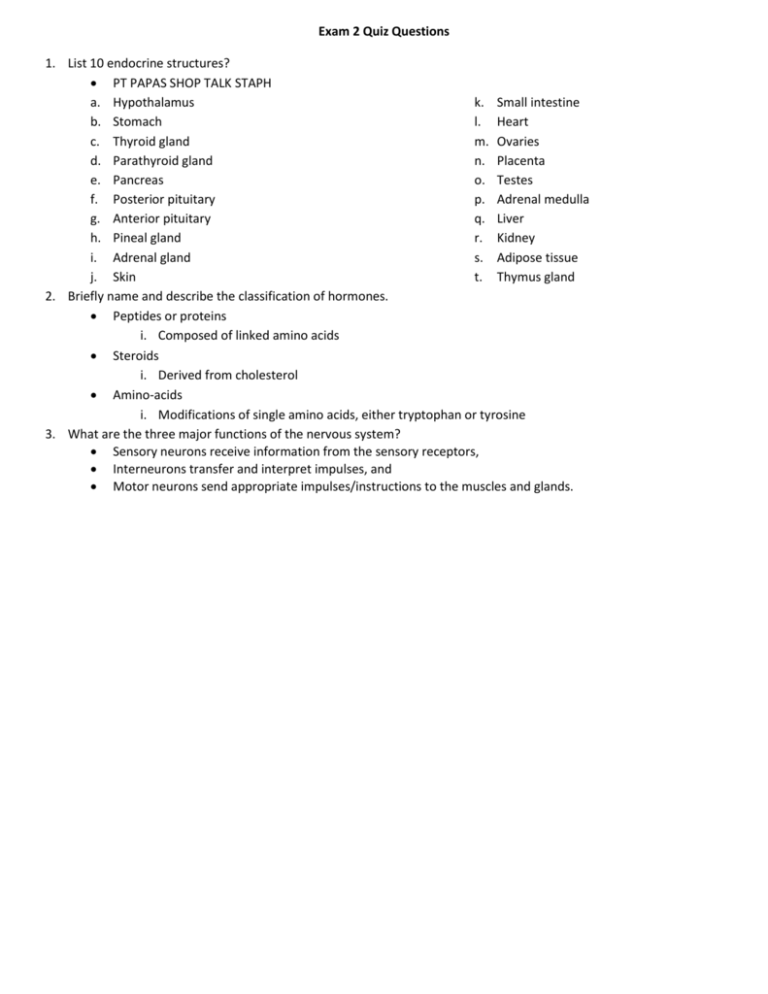
Exam 2 Quiz Questions 1. List 10 endocrine structures? PT PAPAS SHOP TALK STAPH a. Hypothalamus k. Small intestine b. Stomach l. Heart c. Thyroid gland m. Ovaries d. Parathyroid gland n. Placenta e. Pancreas o. Testes f. Posterior pituitary p. Adrenal medulla g. Anterior pituitary q. Liver h. Pineal gland r. Kidney i. Adrenal gland s. Adipose tissue j. Skin t. Thymus gland 2. Briefly name and describe the classification of hormones. Peptides or proteins i. Composed of linked amino acids Steroids i. Derived from cholesterol Amino-acids i. Modifications of single amino acids, either tryptophan or tyrosine 3. What are the three major functions of the nervous system? Sensory neurons receive information from the sensory receptors, Interneurons transfer and interpret impulses, and Motor neurons send appropriate impulses/instructions to the muscles and glands. Short Answer Questions 1. Draw and completely label a graph showing what would happen to the resting membrane potential if the sodium/potassium pumps where made non-functional and immediately after the nerve was stimulated to threshold. a. Resting membrane potential b. Depolarizing stimulus c. Membrane depolarizes to threshold. Voltage-gated Na+ enters cell. Voltage-gated K+ channels begin to open. d. Rapid Na+ entry depolarizes cell e. Na+ channels close and slower K+ channels open f. K+ moves from cell to extracellular fluid g. K+ channels remain open and additional K+ leaves the cell, hyperpolarizing it. h. Voltage-gated K+ channels close, less K+ leaks out of cell. i. Cell returns to resting ion permeability and resting membrane potential. 2. You are walking to class, pondering physiology, when you trip over an uneven place in the sidewalk, and fall. Unhurt but embarrassed and angry, you jump up and glance around to see if anyone is watching. From your knowledge of neuroanatomy and function, explain how the following areas of the brain might be involved in this scenario. a. cerebrum b. cerebellum c. limbic system 3. Write out the Nernst equation and explain its significance. What is the equilibrium potential for an ion? [𝑖𝑜𝑛] 61 𝑙𝑜𝑔 [𝑖𝑜𝑛]𝑜𝑢𝑡 𝑧 𝑖𝑛 𝐸𝑖𝑜𝑛 (𝑖𝑛 𝑚𝑉) = The Nernst equation is used to find the equilibrium potential of an Eion Eion is the membrane potential at which the force due to the concentration gradient acting on an ion is equal and opposite to the force due to the electrical gradient 4. In multiple sclerosis, there is progressive intermittent damage to the myelin sheath of axons of the central nervous system. One symptom is poor motor control of the affected area. Why does destruction of the myelin sheath affect motor control? a. Action potential conduction is slowed and when ions leak out of the now-uninsulated regions of membrane between the channel-rich nodes of Ranvier, the depolarization the reaches a node may not be above threshold and conduction may fail. 5. List the anatomical and functional categories of neurons. a. Anatomic · Pseudounipolar · Bipolar · Anaxonic · Multipolar b. Function · Sensory (afferent) · Interneuron · Motor (efferent) SAME - Sensory=Afferent, Motor=Efferent 6. Using ions, describe two ways a cell can become hyperpolarized. a. efflux of K+ (a cation) b. influx of Cl– (an anion) c. If a cell has Na+ or Ca2+ currents at rest, then inhibition of those currents will also result in a hyperpolarization. · increase in outward current, or a decrease in inward current 7. Imagine a neuron which has several hundred axonal knobs imprinting on it. The majority of these axonal knobs are shown to be “firing.” However, the neuron in question does not transmit an impulse. Give a valid explanation of why this could happen. a. This happens because some event occurs between the arrival of the action potential at the axon terminal and the depolarization of the postsynaptic cell. b. The axonal knobs fire, creating one inhibitory postsynaptics potential (IPSP) and two excitatory graded potentials that sum as they reach the trigger zone. The IPSP counteracts the two EPSPs, creating an integrated signal that is below threshold. As a result, no action potential leaves the trigger zone. 8. Neurons are treated with a drug that instantly and permanently stops the Na, K-ATPase pumps. What happens to the resting membrane potential immediately and over time? 9. Describe the paths a preganglionic sympathetic fiber may take to reach its synapse point with the post ganglionic neuron. a. Chapter 11 10. Name the cranial nerves that are purely sensory and name those that are involved with eye movement a. Sensory b. Eye movement · I Olifactory · III Oculomotor · II Optic · IV Trochlear · VIII Vestibularchlear · VI Abducens "Some Say Marry Money But My Brother Says Big Brains Matter More": · From I to XII: Sensory Both Sensory Sensory Motor Both Motor Both Both Motor Motor Motor · Alternatives for "Brains": Boobs, Buns, Bras. 11. Contrast the somatic and the autonomic nervous system; mention at least three characteristics of each. a. Chapter 11 a. Somatic nervous system · Skeletal muscles · Voluntary system b. Autonomic nervous system 1. Sympathetic Fight or flight 2. Parasympathetic Rest and digest · Smooth muscle · Involuntary system Efferent division of the PNS 12. Define neurotransmitter. What are the different classes of neurotransmitter? Name two from each class. a. A chemical signal released by a neuron that influences the neuron’s target cell or the message at a chemical synapse · Elicits the same physiological response when applied to the post synaptic cell · It should be release by the pre-synaptic neuron · Its action must be blocked by the same agents that block the natural transmission b. 5 Different classes · Acetylcholine (Ach) 1. Nicotinic · Peptides 2. Muscarinic 1. Substance P · Amines 2. Enkephalins (opioid peptide) 1. Norepinephrine 3. Endorphins (opioid peptide) 2. Dopamine 4. Cholecystokinin (CCK) 3. Serotonin 5. Vasopressin 4. Histamine 6. Artrial natriuretic peptide · Amino acids · Purines 1. Glutamate 1. Adenosine 2. Gamma-aminobutyric acid 2. Adenosine monophosphate (AMP) (GABA) 3. Adenosine triphosphate (ATP) 3. Glycine · Gases 4. Aspertate 1. Nitric oxide 13. What forces maintain a steady state “resting” membrane potential? c. The Donnan Effect - Simplified the donnan effect can be described as large impermeant negatively charged intracellular molecules attracting positively charged ions such as Na+, K+ and repelling negative ones such Cld. Membrane Selectivity (Difference in permeabilities of ions) - Membrane selectivity is the difference in permeabilites between different ions for example the plasma membrane is far more permeable to potassium than sodium. e. Active Transport (Na/K ATPase) - Active transport is the mediated process of moving particles across biological membrane against a concentration gradient. If the process uses chemical energy, such as from ATP, it is termed primary active transport. Secondary active transport involves the use of an electrochemical gradient. 14. If the intracellular concentration for sodium is doubled, what would the Nerst potential for sodium be? 145 f. 𝑧 = 61 ∗ 𝑙𝑜𝑔30 = 41.05𝑚𝑀 · Na+145mM in extracellular fluid · Na+ 15mM in intracellular fluid g. K+ 5mM ecf & 150mM icf h. CL- 108mM eft & 10mM icf i. Ca2+ 1mM ecf & .0001 mM icf 15. How is the action of neurotransmitters terminated? a. Diffuse away from the synapse b. Inactivated by enzymes in the synapse cleft c. Transported back into the presynaptic cell or into adjacent neurons of glial cells 16. List four different types of glial cells, and briefly explain the role of each. a. Satellite cells - They supply nutrients to the surrounding neurons and also have some structural function. Satellite cells also act as protective, cushioning cells. b. Schwann cells – (PNS myelin) Myelinating Schwann cells wrap around axons of motor and sensory neurons to form the myelin sheath. the conduction of nervous impulses along axons, nerve development and regeneration, trophic support for neurons, production of the nerve extracellular matrix, modulation of neuromuscular synaptic activity, and presentation of antigens to T-lymphocytes. c. Oligodendrocytes - (CNS myelin) their main function is the insulation of axons in the CNS. · Satellite oligodendrocytes are functionally distinct from most oligodendrocytes. They are not attached to neurons and, therefore, do not serve an insulating role. They remain apposed to neurons and regulate the extracellular fluid. d. Microglia - act as the first and main form of active immune defense in the central nervous system (CNS). Scavenging, Phagocytosis, Cytotoxicity, Antigen presentation, Synaptic stripping, Promotion of repair, Extracellular signaling e. Astrocytes - biochemical support of endothelial cells that form the blood–brain barrier, provision of nutrients to the nervous tissue, maintenance of extracellular ion balance, and a role in the repair and scarring process of the brain and spinal cord following traumatic injuries. f. Ependymal cells - the production of cerebrospinal fluid (CSF) and BBB 17. Describe the path sound must take to reach the inner ear. Chapter 10 18. Trace the path of cerebrospinal fluid from its point of production until it is reabsorbed into the blood. a. CSF is produced by the chorid plexus found on the walls of the ventricles → then flows into the subarachnoid space between the pia matter and the arachnoid membrane → surrounding brain and spinal cord tissue → after that it is absorbed by villi in the arachnoid membrane in the cranium 19. How is grey matter different from whit matter? a. Grey matter · Unmyelinated nerve cell bodies, dendrites, axon terminals · Consists of sensory and motor nuclei · neuronal cell bodies, neuropil (dendrites and both unmyelinated axons and myelinated axons), glial cells (astroglia and oligodendrocytes) and capillaries b. White matter · mostly contains myelinated axon tracts · axons carrying information to and from the brain 20. Compare and contrast the nervous and endocrine systems in terms of their ability to exert control over functions. 21. What would happen if the ventral root of a spinal nerve were damaged or cut?

